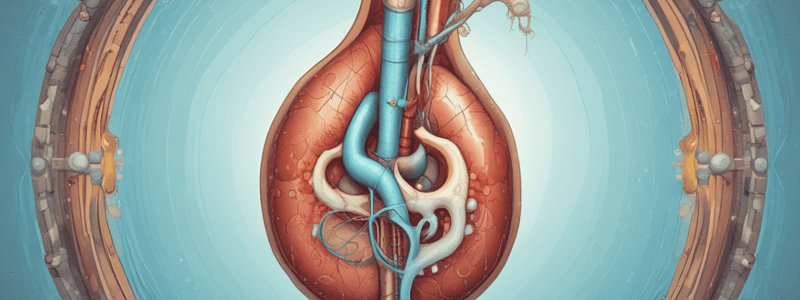Podcast
Questions and Answers
What distinguishes long-looped nephrons from short-looped nephrons?
What distinguishes long-looped nephrons from short-looped nephrons?
- Long-looped nephrons have glomeruli closer to the surface of the cortex.
- Long-looped nephrons generally possess a thin ascending limb. (correct)
- Short-looped nephrons extend deeper into the inner medulla.
- Short-looped nephrons have a thin ascending limb.
Which part of the nephron is exclusively found in the inner medulla?
Which part of the nephron is exclusively found in the inner medulla?
- Distal convoluted tubule
- Thick ascending limb
- Thin ascending limb (correct)
- Proximal tubule
How do short-looped nephrons primarily differ in their descending limbs compared to long-looped nephrons?
How do short-looped nephrons primarily differ in their descending limbs compared to long-looped nephrons?
- They have a countercurrent flow configuration.
- They do not have a shared collecting duct system.
- They surround vascular bundles in the outer medulla. (correct)
- They are located in the inner medulla.
What primarily characterizes the loops of Henle in both long-looped and short-looped nephrons?
What primarily characterizes the loops of Henle in both long-looped and short-looped nephrons?
The transition from thin to thick ascending limbs occurs at which kidney region?
The transition from thin to thick ascending limbs occurs at which kidney region?
In mammalian kidneys, which type of nephron does not reach into the medulla?
In mammalian kidneys, which type of nephron does not reach into the medulla?
During tubular fluid flow, where does the fluid exit from the thick ascending limbs?
During tubular fluid flow, where does the fluid exit from the thick ascending limbs?
What is the structural characteristic of the descending thin limbs of long-looped nephrons in the inner medulla?
What is the structural characteristic of the descending thin limbs of long-looped nephrons in the inner medulla?
Which structure receives tubular fluid after the proximal convoluted tubules?
Which structure receives tubular fluid after the proximal convoluted tubules?
What significant feature is observed in the configuration of loops of Henle?
What significant feature is observed in the configuration of loops of Henle?
Study Notes
Independent Regulation of Water and Salt Excretion
- Kidneys maintain homeostasis by regulating water, NaCl, acids, K+, and urea excretion.
- Independent regulation of water and solute excretion enables kidneys to adapt to varying water intakes.
- Renal concentrating and diluting mechanisms are crucial for maintaining balance in excretion.
Renal Water Excretion
- Arginine vasopressin (AVP), or antidiuretic hormone (ADH), regulates renal water excretion.
- AVP secretion increases when blood osmolality surpasses approximately 292 mOsm/kg H2O, as sensed by hypothalamic osmoreceptors.
- Other factors, like arterial underfilling and physical stress, can influence AVP secretion regardless of osmotic pressure.
- Higher AVP levels lead to lower urine output (antidiuresis); lower levels result in increased urine output (diuresis).
- Urine osmolality varies with AVP levels; high AVP correlates with high urine osmolality and vice versa.
Kidney Structure in Urinary Concentrating and Diluting Process
- The renal medulla plays a key role in the independent regulation of water and sodium excretion through complex nephron structures.
- Nephrons are organized to facilitate a countercurrent flow, optimizing the concentrating and diluting functions of urine.
- The anatomical configuration of nephron segments and their vasculature (vasa recta) is critical for kidney function.
Aquaporins and Transporters
- Major aquaporin channels include AQP1, AQP2, AQP3, and AQP4, which facilitate water transport in various nephron segments.
- Urea transporters (UT-A1, UT-A2, UT-A3) are present in specific nephron areas, playing a role in urea reabsorption.
- Ion transporters such as Na-H exchanger (NHE3) and Na-K-2Cl cotransporters (NKCC2 and NKCC1) are essential for sodium reabsorption.
Nephron Types and Anatomy
- Kidneys have long-looped and short-looped nephrons, with specific structural configurations influencing their functions.
- Short-looped nephrons have shallow glomeruli and loops that extend into the outer medulla.
- Long-looped nephrons feature deeper glomeruli and loops that extend into the inner medulla.
- Cortical nephrons, potentially present in humans, possess loops that do not reach the medulla, impacting urine concentration capabilities.
Loop of Henle and Countercurrent Mechanism
- The structure of the Loop of Henle facilitates a countercurrent exchange mechanism, critical for the kidney's ability to concentrate urine.
- The descending limb allows for water reabsorption, while the thick ascending limb actively transports sodium and chloride out of the tubular fluid.
Regional Kidney Morphology
- The transition between thin and thick ascending limbs marks the inner-outer medullary border.
- Different nephron segments have unique histologic properties and functional roles in fluid and electrolyte balance.
Transportation Pathways Overview
- Solute and water transport pathways are coordinated across various nephron segments, including the proximal tubule, thick ascending limb, and collecting ducts.
- The organization of transport proteins and channels is tailored to ensure efficient reabsorption of water and solutes crucial for body homeostasis.
Studying That Suits You
Use AI to generate personalized quizzes and flashcards to suit your learning preferences.
Description
Explore the crucial functions of the kidney in maintaining homeostasis through independent regulation of water and salt excretion. Understand how various ions and compounds influence bodily fluids, acid-base balance, and nitrogen levels. Test your knowledge on these vital kidney functions that truly matter for overall health.




